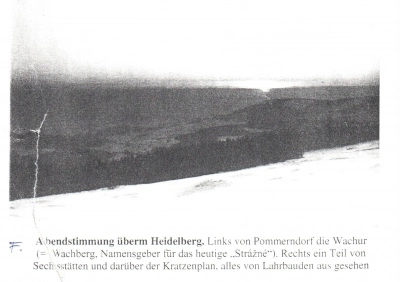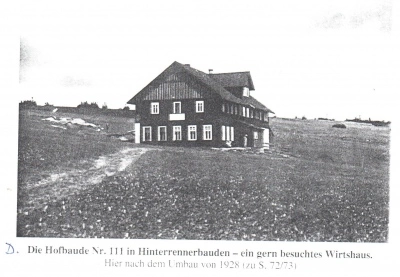History of Friesovy boudy
 The first mention of Friesovy boudy is in the Vrchlabí land register, where in 1676 Jiří Fries is mentioned, and who was allowed to build a structure here. Until 1882, Friesovy boudy belonged to the cadaster of the village of Dolní Dvůr and then to the village of Strážné, where in 1900 seven Fries families were registered. Residents here engaged in cattle breeding, dairy production and silage.
The first mention of Friesovy boudy is in the Vrchlabí land register, where in 1676 Jiří Fries is mentioned, and who was allowed to build a structure here. Until 1882, Friesovy boudy belonged to the cadaster of the village of Dolní Dvůr and then to the village of Strážné, where in 1900 seven Fries families were registered. Residents here engaged in cattle breeding, dairy production and silage.
With the development of tourism in the 2nd quarter of the 19th century. In addition to farming, the highlander residents, living along the main tourist routes, also devoted themselves to new forms of livelihood such as mountain carriers and guides and adapted their dwellings to provide hospitality to tourists. Milk, cheese, coffee and spirits were sold here.
Friesovy Boudy was off the main tourist trails for a long time. One of the oldest roads, the Silesian Road (Lahrbusch), essentially bypassed Friesovy boudy, and went by Jilemnice, Vrchlabí, Strážná and Lahrovy bouda to Výrovka, from there it went between Studniční and Luční hora around Luční and Hamlova bouda to Silesia. It is also said to have been the usual smuggling route. It was only after the completion of the cable car to Pláň that Friesovy boudy also became a tourist resort.
 Life for highlanders in the first half of the 20th century was far from easy. At that time, electricity had not yet been introduced in the mountains, so it was mostly lit by kerosene and candles. It also sometimes led to fires, but their most common cause was a lightning strike or a faulty chimney. They usually baked their own bread at home in each house, usually once every 14 days. Vegetables and fruits did not thrive at these altitudes. They ate mostly carrots and radishes they bought in Vrchlabí, as well as cabbage, which they picked and served all year round as a source of vitamins.
Life for highlanders in the first half of the 20th century was far from easy. At that time, electricity had not yet been introduced in the mountains, so it was mostly lit by kerosene and candles. It also sometimes led to fires, but their most common cause was a lightning strike or a faulty chimney. They usually baked their own bread at home in each house, usually once every 14 days. Vegetables and fruits did not thrive at these altitudes. They ate mostly carrots and radishes they bought in Vrchlabí, as well as cabbage, which they picked and served all year round as a source of vitamins.
They did not keep pigs because they did not have food for them. They bought tools and had them repaired in Vrchlabí, there was no blacksmith in the mountains. The postman went with the post regularly every day and also delievered newspapers. The source of information was also a flashlight radio, which they had at the school in Rennerovky and in numerous pubs (Friesovky, Lahrovky, Klínovky, Dvorská bouda and Strážné had a pub).
Medical care was not very accessible to people and was very expensive. The general practitioner and dentist were only in Vrchlabí, and in serious cases when they came for a doctor, it was usually too late. In the early 1930s, foreign trade increased considerably and became a good secondary income for most mountain residents. Tourists from both the Czechoslovakia and Germany used to come here. Tourism was the most common reason for contact with the Czech population, because the Czechs by and large did not live here until the end of the war, only in Vrchlabí, where there was also a Czech school.
 House Number 95 (Hotel Friesovy boudy)
House Number 95 (Hotel Friesovy boudy)
The original owner of the mountain farm was August Thomas Fries, then his brother Josef. Vinzenz Lahr from Klínovek No. 84 acquired the house from him, who rebuilt the homestead after a fire around 1910. He sold the house to Josef Buchbergr and moved out. In 1921, Buchberger, from Lahrovky No. 82, also moved to Darre near Tannwald – Polaum (today's village and dam Souš in the Jizera Mountains). Josef Hoffman bought the house from him, rebuilt it and bought the land of the neighboring house no. 96. The farm had five hectares of meadows, five cows, a heifer, and a draft horse. In 1935, Josef Hoffman obtained a license to operate a restaurant. The inn had thus become a popular place for both residents and guests (there were 5-6 guest rooms). In the pleasant pub, young and old often met to sit with beer and wine, and even hard alcohol (most often it was schnapps). Renner's band played at popular dance parties. On June 19, 1945, the married couple with two daughters and grandchildren were expelled.
At the end of autumn 1945, the building was assigned to a Czech businessman as an inn and hostel. After 1948, the building was expropriated and became the property of the Prague Škoda Works. In 1987, the building was completely demolished and rebuilt as "Friesovy Bouda" closer to the forest. Hans Adolf also knows from his father that Wenzel Lahr's family also lived there at the time of "Hof-Winza-Seff". This, in his time, was the most successful cross-country skier who died the First World War. After 1920, his widow Anna Lahrová moved to Harrachov with her two sons. The older of them (1913), Hans Lahr, later became a well-known cross-country skier and world record holder in ski jumping.



















